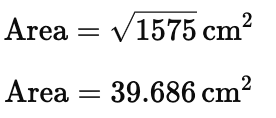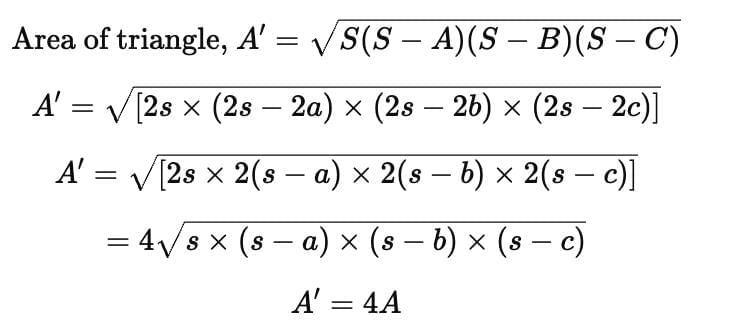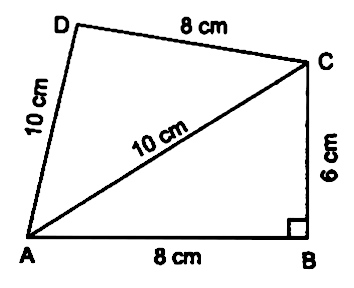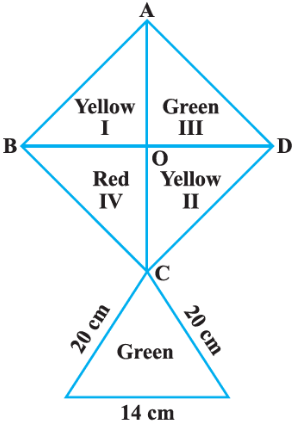Class 9 Maths Chapter 10 Question Answers - Heron’s Formula
Q1. Find the area of a triangle whose sides are 8 cm, 10 cm, and 12 cm.
Sol: Let the semi-perimeter s be:
Heron’s formula for the area of the triangle:
Substituting the values:
Q2. Find the area of a triangle whose sides are 4.5 cm and 10 cm and perimeter 20.5 cm.
Sol:Given:
Side a = 4.5 cm
Side b = 10 cm
Perimeter of triangle = 20.5 cm
Perimeter = a + b + c
20.5 = 4.5 + 10 + c20.5 = 14.5 + c
c = 20.5 – 14.5
c = 6 cm
Semiperimeter (s):
Using Heron’s formula,
Q3. If every side of a triangle is doubled, by what percentage is the area of the triangle increased?
Sol:Let a, b and c be the sides of a triangle.Semiperimeter (s):
Now, if each of the side is doubled, then the new sides of a triangle are:
A = 2a, B = 2b, C = 2c
New Semiperimeter (S):
By Heron’s formula,
Hence, the area is increased by 300%, if the sides of the triangle are doubled.
Q4. A triangular field has sides 130 m, 140 m, and 150 m. A gardener has to put a fence all around it and also plant grass inside. How much area does he need to plant grass?
Sol:Given,
Sides of triangular park are 120m, 80m and 50m.
Semi perimeter (s):
Using Heron’s formula, we have;
Area of triangle
The area that needs to be planted with grass is 8400m2.
Q5. Find the area of a triangle whose two sides are 16 cm and 20 cm, and the perimeter is 48 cm.
Sol:Assume that the third side of the triangle is x.
Now, the three sides of the triangle are 16 cm, 20 cm, and 'c' cm.
It is given that the perimeter of the triangle is 48 cm:
Perimeter= a + b + c
48 = 16 + 20 + c
c = 48 − (16 + 20)
c = 48 − 36
c = 12cm
Q6. The sides of a triangle are in the ratio 8: 15: 17 and its perimeter is 680 cm. Find its area.
Sol: Given:The ratio of the sides of the triangle is given as 8: 15: 17.
Let the common ratio between the sides of the triangle be "x".Thus, the sides are 8x,15x, and 17x.
It is also given that the perimeter of the triangle is 680 cm:
8x + 15x + 17x = 680cm
40x = 680cm
x = 17
Now, the sides of the triangle are:
8 × 17 = 136cm,
15 × 17 = 255cm,
17 × 17 = 289cm
the semi-perimeter of the triangle
Using Heron's formula:Area
Q7. The lengths of the sides of a triangle are in the ratio 3 : 4 : 5 and its perimeter is 120 cm, find its area.
The sides are in the ratio of 3 : 4 : 5.
Let the sides be 3x, 4x and 5x.
∴ Perimeter = 3x + 4x + 5x = 12x
Now 12x = 120 [Perimeter = 120 cm]
⇒ x =(120/12) = 10
∴ Sides of the triangle are: a = 3x = 3 x 10 = 30 cm
b = 4x = 4 x 10 = 40 cm
c = 5x = 5 x 10 = 50 cm
Now, semi-perimeter (s) = (120/12)
cm = 60 cm
∵ (s – a) = 60 – 30 = 30 cm
(s – b) = 60 – 40 = 20 cm
(s – c) = 60 – 50 = 10 cmUsing Heron’s formula, we have
Thus, the required area of the triangle = 600 cm2.
Q8. Find the area of a quadrilateral ABCD in which AB = 8 cm, BC = 6 cm, CD = 8 cm, DA = 10 cm and AC = 10 cm.
In ΔABC, ∠B = 90°
∴ area of right (rt ΔABC) = (1/2) x 8 x 6 cm2 = 24 cm2
In ΔACD,
a = AC = 10 cm b = AD = 10 cm c = CD = 8 cm
∴Area of ΔACD
= 2 x 4√21 = 8√21 cm2
= 8 x 4.58 cm2 = 36.64 cm2
Now, area of quadrilateral ABCD = ar (ΔABC) + ar (ΔACD)
= 24 cm2 + 8√21 cm2
= 24 cm2 + 36.64 cm2
= 60.64 cm2
Q9. How much paper of each shade is needed to make a kite given in the figure, in which ABCD is a square of diagonal 44 cm.
∵ The diagonals of a square bisect each other at right angles
∴ OB = OD = OA = OC = (44/2) = 22 cm
Now, ar rt (Δ –I) = (1/2)× OB × OA
= (1/2) × 22 × 22 cm2 = 242 cm2
Similarly ar rt (Δ –II) = arrt(Δ–III) = ar rt (Δ –IV) = 242 cm2∵ Sides of ΔCEF are 20 cm, 20 cm and 14 cm
⇒ Area of ΔCEF
Now, area of yellow paper = ar (Δ – I) + ar (Δ – II)
= 242 cm2 + 242 cm2 = 484 cm2
Area of red paper = ar (Δ – IV) = 242 cm2
Area of green paper = ar (Δ – III) + ar ΔCEF
= 242 cm2 + 131.14 cm2
= 373.14 cm2
|
40 videos|471 docs|57 tests
|
FAQs on Class 9 Maths Chapter 10 Question Answers - Heron’s Formula
| 1. What is Heron's Formula and how is it used to calculate the area of a triangle? |  |
| 2. Can Heron's Formula be used for all types of triangles? |  |
| 3. How do you find the semi-perimeter in Heron's Formula? |  |
| 4. What are the steps to apply Heron's Formula to find the area of a triangle? |  |
| 5. Are there any limitations or conditions when using Heron's Formula? |  |
















































